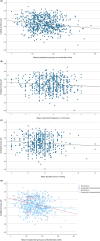Uterine contractile activity and neonatal outcome - A blind analysis of a randomized controlled trial cohort
- PMID: 38567650
- PMCID: PMC11168260
- DOI: 10.1111/aogs.14838
Uterine contractile activity and neonatal outcome - A blind analysis of a randomized controlled trial cohort
Abstract
Introduction: Sufficient contractions are necessary for a successful delivery but each contraction temporarily constricts the oxygenated blood flow to the fetus. Individual fetal or placental characteristics determine how the fetus can withstand this temporary low oxygen saturation. However, only a few studies have examined the impact of uterine activity on neonatal outcome and even less attention has been paid to parturients' individual characteristics. Our objective was therefore to find out whether fetuses compromised by maternal or intrapartum risk factors are more vulnerable to excessive uterine activity.
Material and methods: Uterine contractile activity was assessed by intrauterine pressure catheters. Women (n = 625) with term singleton pregnancies and fetus in cephalic presentation were included in this secondary, blind analysis of a randomized controlled trial cohort. Intrauterine pressure as Montevideo units (MVU), contraction frequency/10 min and uterine baseline tone were calculated for 4 h prior to birth or the decision to perform cesarean section. Uterine activity in relation to umbilical artery pH linearly or ≤7.10 was used as the primary outcome. Need for operative delivery (either cesarean section or vacuum-assisted delivery) due to fetal distress was analyzed as a secondary outcome. In addition, belonging to vulnerable subgroups with, for example, chorioamnionitis, hypertensive or diabetic disorders, maternal smoking or neonatal birthweight <10th percentile were investigated as additional risk factors.
Results: A linear decline in umbilical artery pH was seen with increasing intrauterine pressure in all deliveries (p < 0.001). Among parturients with suspected chorioamnionitis, every increasing 10 MVUs increased the likelihood of umbilical artery pH ≤7.10 (odds ratio [OR] 1.17, 95% confidence interval [CI] 1.02-1.34, p = 0.023). The need for operative delivery due to fetal distress was increased among all laboring women by every increasing 10 MVUs (OR 1.05, 95% CI 1.01-1.09, p = 0.015). This association with operative deliveries was further increased among parturients with hypertensive disorders (OR 1.23, 95% CI 1.05-1.43, p = 0.009) and among those with diabetic disorders (OR 1.13, 95% CI 1.04-1.28, p = 0.003).
Conclusions: Increasing intrauterine pressure impairs umbilical artery pH especially among parturients with suspected chorioamnionitis. Fetuses in pregnancies affected by chorioamnionitis, hypertensive or diabetic disorders are more vulnerable to high intrauterine pressure.
Keywords: Montevideo unit; chorioamnionitis; fetal distress; intrauterine pressure; neonatal outcome; operative delivery; umbilical artery pH.
© 2024 The Authors. Acta Obstetricia et Gynecologica Scandinavica published by John Wiley & Sons Ltd on behalf of Nordic Federation of Societies of Obstetrics and Gynecology (NFOG).
Conflict of interest statement
The authors have stated explicitly that there are no conflicts of interest in connection with this article.
Figures


Similar articles
-
Intrauterine Contraction Monitoring in Chorioamnionitis: A Secondary, Blinded Analysis of a Randomised Controlled Trial Cohort.BJOG. 2025 May;132(6):795-804. doi: 10.1111/1471-0528.18076. Epub 2025 Jan 16. BJOG. 2025. PMID: 39815803 Free PMC article. Clinical Trial.
-
Uterine artery Doppler in early labor and perinatal outcome in low-risk term pregnancy: prospective multicenter study.Ultrasound Obstet Gynecol. 2023 Aug;62(2):219-225. doi: 10.1002/uog.26199. Ultrasound Obstet Gynecol. 2023. PMID: 36905679
-
Association between Elevated Intrauterine Resting Tone during Labor and Neonatal Morbidity.Am J Perinatol. 2024 May;41(S 01):e1344-e1351. doi: 10.1055/a-2022-9588. Epub 2023 Jan 31. Am J Perinatol. 2024. PMID: 36720261
-
Cesarean section on request at 39 weeks: impact on shoulder dystocia, fetal trauma, neonatal encephalopathy, and intrauterine fetal demise.Semin Perinatol. 2006 Oct;30(5):276-87. doi: 10.1053/j.semperi.2006.07.009. Semin Perinatol. 2006. PMID: 17011400 Review.
-
Effects of induction of labor prior to post-term in low-risk pregnancies: a systematic review.JBI Database System Rev Implement Rep. 2019 Feb;17(2):170-208. doi: 10.11124/JBISRIR-2017-003587. JBI Database System Rev Implement Rep. 2019. PMID: 30299344 Free PMC article.
Cited by
-
Intrauterine Contraction Monitoring in Chorioamnionitis: A Secondary, Blinded Analysis of a Randomised Controlled Trial Cohort.BJOG. 2025 May;132(6):795-804. doi: 10.1111/1471-0528.18076. Epub 2025 Jan 16. BJOG. 2025. PMID: 39815803 Free PMC article. Clinical Trial.
References
-
- Bakker PCAM, Kurver PHJ, Kuik DJ, Van Geijn HP. Elevated uterine activity increases the risk of fetal acidosis at birth. Am J Obstet Gynecol. 2007;196:313.e1‐313.e6. - PubMed
-
- Hauth JC, Hankins GDV, Gilstrap LC. Uterine contraction pressures achieved in parturients with active phase arrest. Obstet Gynecol. 1991;78:344‐347. - PubMed
-
- Hauth JC, Hankins GDV, Gilstrap LC, Strickland DM, Vance P. Uterine contraction pressures with oxytocin induction/augmentation. Obstet Gynecol. 1986;68:305‐309. - PubMed
-
- Rimsza RR, Raghuraman N, Carter EB, Kelly JC, Cahill AG, Frolova AI. Association between elevated intrauterine resting tone during labor and neonatal morbidity. Am J Perinatol. 2023;31:a‐2022‐9588. - PubMed
Publication types
MeSH terms
Grants and funding
LinkOut - more resources
Full Text Sources

